Using a 4/3 to OM Adapter on Olympus E-System Cameras
Using a 4/3 (Four Thirds) to OM adapter your old OM lenses can be used with your Olympus E-System digital (DSLR) camera. The pictures illustrate what the adapter looks like and how it attaches to the lens.
After the launch of the E-1, Olympus produced and sold an adapter called the MF-1. It adapted any OM system lens to the Four Thirds mount used by E-System and other maker's cameras. (For those who are unfamiliar with Four Thirds, it provides a standard lens mount shared by camera makers who are partners in the Four Thirds group. Thus all Four Thirds (4/3) lenses work on all Four Thirds cameras. This means a Panasonic lens can be mounted to an Olympus camera. The adapter enables photographers to mount OM lenses on any Four Thirds camera.) With the adatper, any OM system lens can be mounted on any E-System camera, the E-1, E-300, E-330, E-500, E-410, E-510 or E-3 and any newer models. They also should work with any 4/3 camera from any maker, such as the Panasonic or Lumix.
You may hear the phrase "legacy lens," "legacy glass" or "legacy optics" in connection with OM lenses. You might ask what is a "legacy lens?" This is a lens, like the OM lenses, that cannot communicate electronically with a 4/3 camera and does not fit the 4/3 mount requirements. An adapter is required to use a legacy lens on your camera.
Where to get an adapter? As far as I know, Olympus still sells the MF-1 OM to 4/3 adapter in their online store, as do several major photo retailers. It costs about $200. Most people buy one of the Chinese-made adapters sold on ebay. That is what I did and I am happy with the results.
Some of the major sellers in the 4/3 adapter market are
- http://myworld.ebay.com/cirrusadapter/ Cirrus
- http://myworld.ebay.com/cowy07/ Cowy07
- http://myworld.ebay.com/fotodiox_gear/ Fotodiox
- http://myworld.ebay.com/jinfinance/ RJ Camera Accessory
- http://myworld.ebay.com/kawaphoto/ Kawa
(alphabetical order)
I bought my OM to 4/3 adapter from http://myworld.ebay.com/cowy07/ and received the item in a timely manner. It is heavily constructed. I wouldn't want to fight someone who had slipped in in his or her boxing glove. I also bought a Minolta MD to 4/3 adapter from RJ camera and am pleased with it.
The best thing to do is look for yourself in the ebay category Cameras & Photo > Lenses & Filters > Lens Accessories > Adapters & Mounts
The photos were shot under CFL lighting.
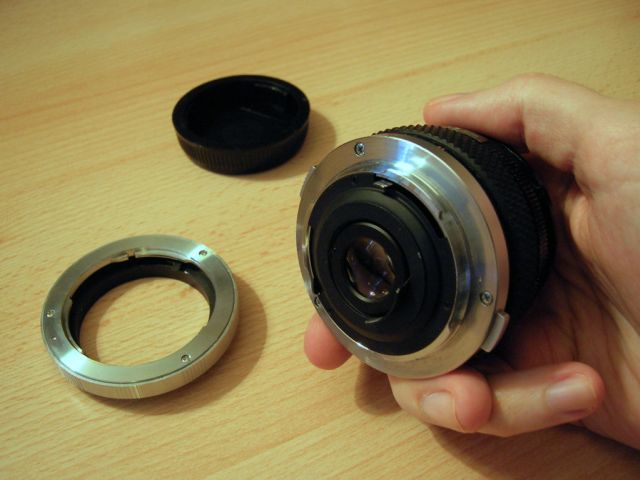
On right is the OM 35mm f/2.8 lens, on left, the OM to 4/3 adapter, in center background, the OM rear lens cap. The lever inside the adapter ring pushes the aperture pin on the lens.
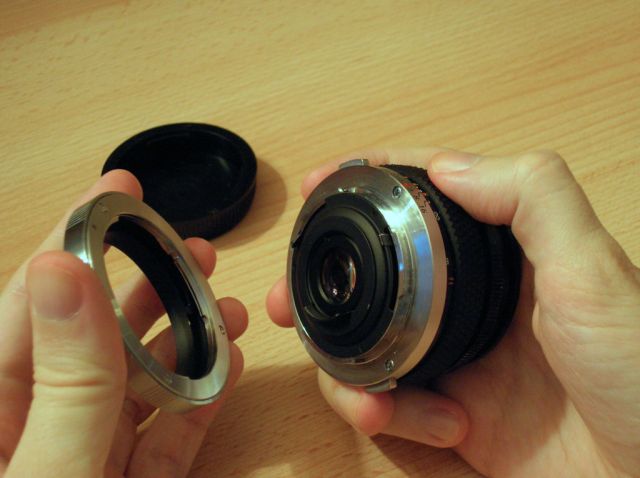
Ready to mount the adapter on the lens. The red dot on the adapter aligns with the red dot on the lens.
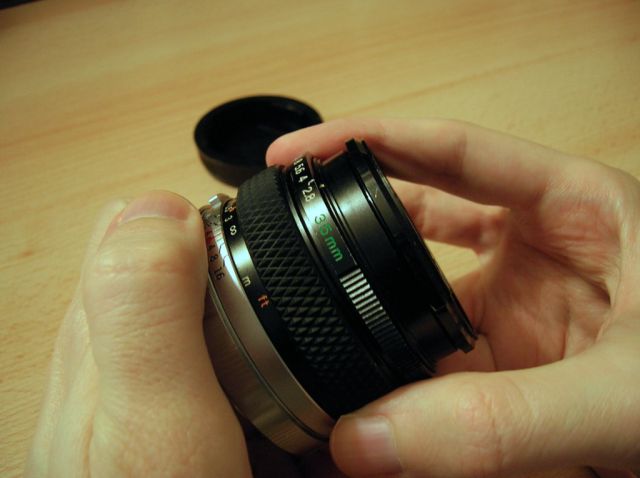
Turn the adapter until it clicks into place. Do not force it, but it can require a firm hand.
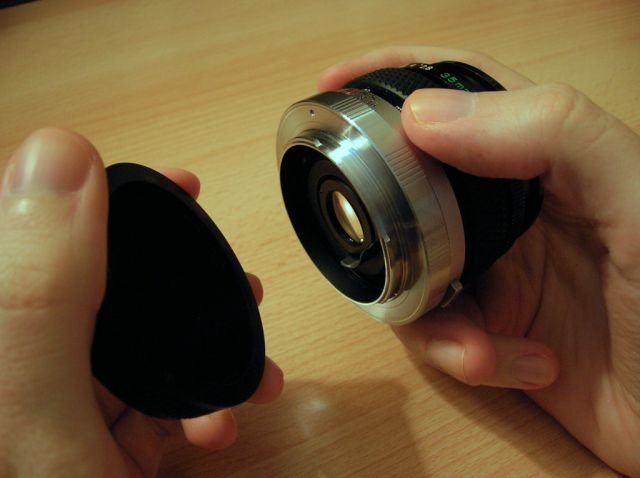
Mounting the rear lens cap.
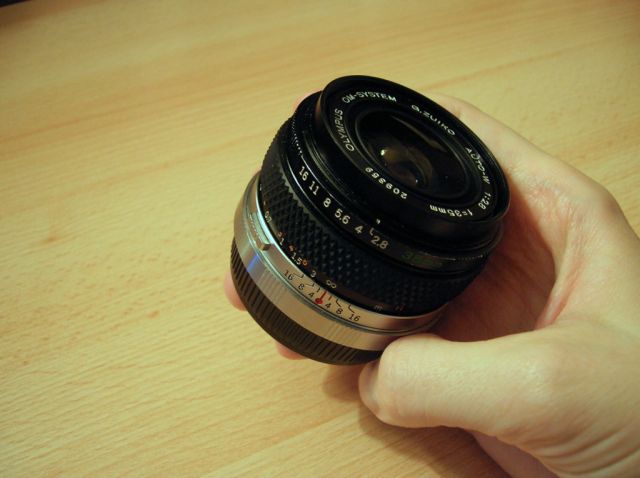
All mounted up.
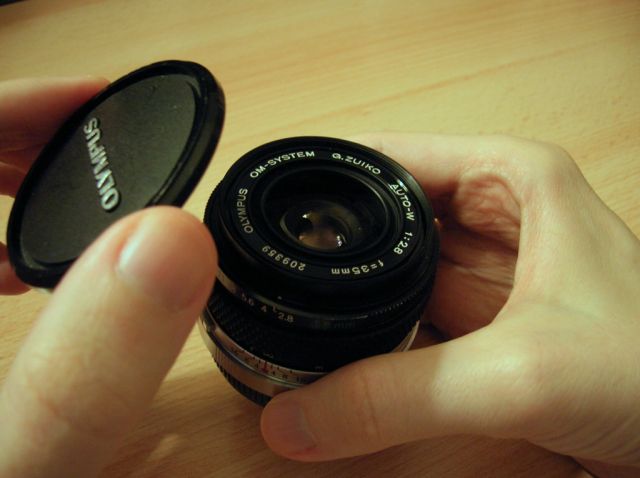
Putting the front lens cap on.
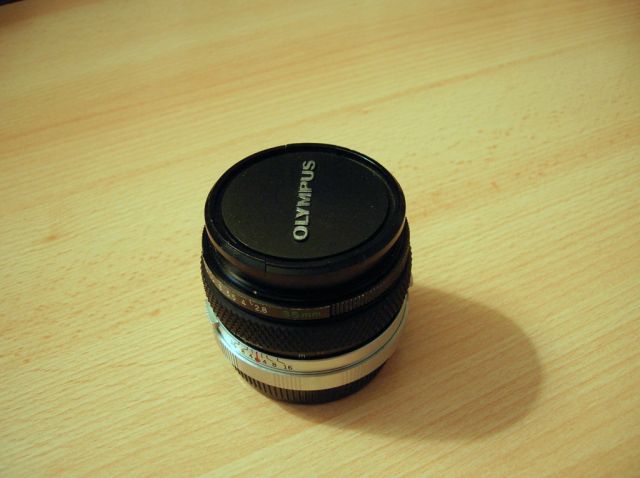
Ready for the camera bag.
Now that you have an adapter, you may be asking what else do I need to know? To get the most out of your legacy glass, you need to know how to shoot with manual focus legacy lenses.
Stop down metering
Because the OM lens cannot communicate electronically with your digital camera, it cannot communicate information such as maximum or minimum aperture or current aperture to the camera. You must select Aperture Priority on the camera and se the aperture manually using the lens aperture ring. This is called "stopped down metering" because it requires you to actually close the aperture to measure the amount of light required for the exposure. In the mid-1970s makers of SLRs began to offer cameras that allowed the photographer to look through the viewfinder, focus and meter with the lens at the widest opening. This made for a brighter viewfinder and more accurate focusing. When the shutter was tripped, the camera stopped the lens down to the aperture desired by the photographer or required by the exposure meter. This happens just for the instant of exposure. So using these lenses on your DSLR is a step backwards in time.
Exposure compensation
Lenses faster than f/2.0 will require some exposure compensation. This is because the viewfinder in most modern digital SLRs intended for the advanced amateur and consumer market were designed to work with slow lenses. The E-System cameras are generally designed to work with lenses no faster than f/2.0 Small lenses, microlenses are used in making the viewfinder brighter. Your camera knows how to compensate for this when using digital lenses, but not when using manual lenses.
Viewfinder issues
Modern DSLR viewfinder designs do not give priority to manual focus. The viewfinders are generally smaller than film-era SLR finders and do not offer focusing aids, such as a split-prism or microprism collar. A split-screen viewfinder can be fitted to E-System cameras, called the KatzEye.
Image Stabilization
As of firmware revision 1.3, the E-510 supports Image Stabilization for manual focus legacy lenses by allowing the user to specify the focal length in the IS menu. This effectively extends image stabilization to all manual focus lenses by nearly every camera manufacturer going back to the dawn of 35mm photography.
Other Information
One of the best sources is Bifos.com Cornucopia article OM Zuiko lenses on the E-1 testing a range of OM Zuiko lenses on the E-1, from 8mm to 500mm.